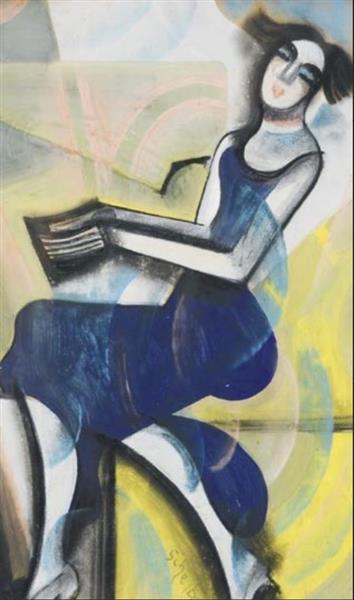Description
The woman playing the piano of Hugó Scheiber is a fascinating example of the distinctive style of this Hungarian painter, often associated with the movement of Fauvism and the avant -garde painting of the twentieth century. Through a vibrant and bold palette, Scheiber's work encapsulates an emotional perception of reality, instead of an objective representation.
In woman playing the piano, the central figure presents a woman who radiates a mixture of serenity and strength. Its position and expression suggest a deep connection with its environment, although the context is deliberately abstract. This approach emphasizes the symbolism of the female figure that, often in Scheiber's work, becomes an icon of Hungarian identity and culture. The woman, in her rich and colorful clothing, is surrounded by a background that seems to vibrate alive through the warm tones full of emotional nuances that characterize Scheiber's palette.
The composition is dynamically made by using fluid forms and organicity in the arrangement of the elements, which mostly seem to evoke nature and sensuality. In its characteristic Fauvista style, Scheiber uses colors that do not always correspond to physical reality, which contributes to creating an almost dreamlike atmosphere. The contours around the figure are often marked, contributing to a sensation of volume and three -dimensionality that invites the viewer to feel the presence of almost tangible women, while lost in the world of color and imagination that surrounds it.
The use of color is undoubtedly one of the most outstanding features of women playing the piano. Intense tones of yellow, oranges and reds combine with softer and fresher nuances, such as green and blue, creating a contrast that enhances the vitality of the female figure. This color game not only attracts visually, but also suggests a dialogue between the figure and its surroundings, symbolizing the duality of life, the internal and the external, the feminine and the natural.
It is important to note that the work is aligned with the thematic explorations that Scheiber made throughout his career, where the female figure is not only central, but also reflects a fusion between art, cultural identity and everyday life. His way of representing women implies a search for beauty in everyday life, where each brushstroke is an expression of their connection with the Hungarian cultural heritage and the European thinking currents of their time.
In the history of art, especially within the context of Hungarian painting of the early twentieth century, a woman playing the piano echoes the ideals of creative freedom and the exploration of the color that marked the evolution of Fauvism. Through his work, Scheiber is established as a bridge between tradition and modernity, offering the viewer an immersion experience in a world of color and emotion.
This work, in its essence, is not only limited to the visual; It also includes a celebration of life, femininity and individual expression, values that continue to resonate in contemporary art. Through woman playing the piano, Hugó Scheiber invites us to reflect on the reality that resides at the intersection of perception and emotion, making it a significant piece within the artistic heritage of Hungary and beyond.
KUADROS ©, a famous paint on your wall.
Hand-made oil painting reproductions, with the quality of professional artists and the distinctive seal of KUADROS ©.
Art reproduction service with satisfaction guarantee. If you are not completely satisfied with the replica of your painting, we refund your money 100%.

